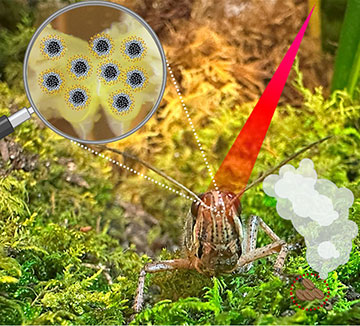Researchers used specially made nanostructures that can absorb light, create heat and act as containers to store and release chemicals on demand to boost neural response in the locust's brain to specific odors and to improve odor identification. [Image: Singamaneni lab]
Technological innovations are often inspired by existing biological systems. After all, evolution has had millions of years of trial and error to perfect certain functions. Insects are some of the most successful organisms on Earth in part because of their many diverse adaptations, making them useful subjects for such mimicry. Observations of butterfly wings are used to create photonic structures and study of the mosquito proboscis led to painless microneedles.
Mimicking the olfactory system, which could be useful for biodiagnostics, homeland security, environmental monitoring and industrial process control, has proven more difficult because of the limitations of existing chemical sensors.
Now, a team of researchers from Washington University in St. Louis, USA, report that they have used a hybrid approach to overcome the challenge of developing effective “e-noses,” or artificial chemical sensing systems, which previously lacked the sensitivity, stability, specificity and tolerance of the real thing (Nat. Nanotechnol., doi: 10.1038/s41565-023-01592-z). Using locusts as subjects, they say that they were able to exploit the photothermal properties and chemical-storage ability of specially designed nanostructures to both enhance the odor-evoked response of the insect and improve odor identification.
Neuromodulation two ways
Since efforts to create human-operated e-noses had fallen short, the team led by Prashant Gupta and Barani Raman decided to harness an actual biological system, choosing locusts because of their large size. “We let the biology do the harder job of converting information about vaporous chemicals into an electrical neural signal,” Raman said in a press release. “These signals are detected in the insect antennae and are transmitted to the brain. We can place electrodes in the brain, measure the locusts’ neural response to odors, and use them as fingerprints to distinguish between chemicals.”
However, the technique is limited by the number of electrodes that can be placed in the insects’ brains and the locations available for placement. In order to get a useful readout, the researchers need to amplify the partial signal produced by the electrode arrays.
The team used two methods to augment locust olfaction. First, they created biocompatible and biodegradable mesoporous silica-coated polydopamine nanoparticles to use as photothermal nanotransducers for photothermal neuromodulation—the conversion of optical input, in this case illumination from a near-infrared laser, into neural perturbations. “The idea is to use the heat generated by nanostructures to locally heat, for example, a nanoheater, and enhance the neural activity,” explained Raman.
Then, in conjunction with this photothermal modulation, the researchers used their nanoparticles as cargo carriers for a neuromodulator called octopamine, which can further enhance olfaction. They encapsulated the nanoparticles in a phase-change material called tetradecanol, which allowed them to trigger the local release of the octopamine on demand by adding optical or thermal stimulation.
Bomb-sniffing cyborg locusts
The researchers found that their dual neuromodulation methods significantly enhanced the odor-evoked responses of individual neurons, as well as the odor prediction accuracy.
When they exposed the locusts to various odors via a custom-designed olfactometer, the researchers found that their dual neuromodulation methods significantly enhanced the odor-evoked responses of individual neurons, as well as the odor prediction accuracy. These modifications build on their previous work, which demonstrated the feasibility of using a biohybrid insect-based e-nose for sensing explosive vapors.
“The nano-enabled neuromodulation strategy we developed opens new opportunities to realize tailored cyborg chemical sensing approaches,” said Prashant Gupta, a graduate student in the lab and first author of the paper, in a press release. “This approach would change an existing passive approach, where information is simply read, into an active one where the capabilities of the neural circuits as a basis for information processing are fully used.”


